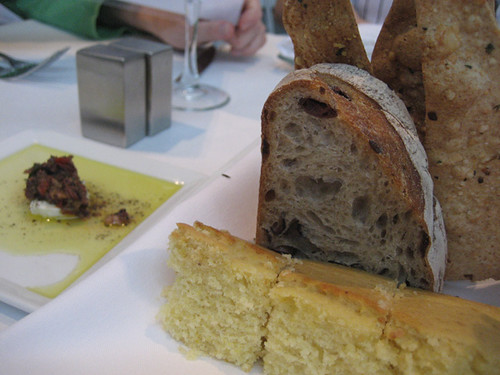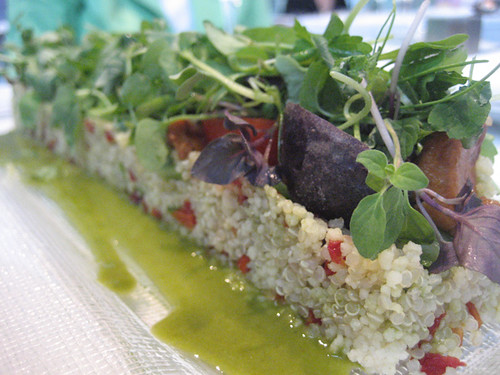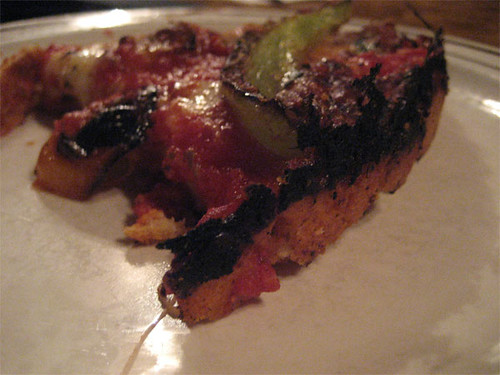Just in case anyone comes here while I’m working hard on about 27 Sky Full of Bacons at once, here’s something to look at: an example of food video (well, film) from long ago. It’s a 1933 MGM short narrated by Pete Smith (of the distinctive nasal draw and bad puns), with a story by Thorne Smith (Topper) and a cast of vaguely familiar character actors (notably Franklin Pangborn, mainly remembered for playing swishy hotel clerks and the like). Is it the world’s first food video? Who knows, but it’s an interesting picture of American kitchens in 1933, in not-entirely-appetizing two-strip Technicolor.

We got a dog. A beagle-pointer mix named Buster.
First thing he chewed up? My copy of The United States of Arugula.
He said the parts about James Beard were tasty, but Alice Waters needed salt.
Otherwise, this’ll be quiet for a few days as I finish up the Mado-related podcast, which is going to be very interesting, I think. I’m also in production on one about foraging, and in pre-production relating to a certain event coming up which you may have heard about on pretty much every other food site in town. So it’s a busy Sky Full of Bacon, and I think you’ll be intrigued by the results.

“Of all the Ritz spécialités that I have originated, it seems to me vichyssoise was really the one that most thoroughly captured the fancy of Americans from coast to coast. But there have been many others which were equally popular with our own guests. Filet of sea bass Pershing, for example, has been a favorite ever since it was first served at the banquet given at the Ritz for General Pershing after World War I. And one of my favorite chicken dishes has been poulet sauté Gloria Swanson, which I concocted especially for the well-known actress and which I prepared for her recently on her television program.”
—Louis Diat, “The Ritz in Retrospect,” Gourmet, January 1951

You would think it would be impossible for a place on the hot Clark Street strip in Andersonville to go unnoticed on LTHForum or, indeed, in local food media generally. Well, except maybe for that little Asian-run pizza hole next to the McDonald’s. But you would be wrong; an Italian deli called Piatto Pronto has managed the feat. Only Yelpers have yipped about it.
It looks promising. Lots of deli meats of what I would call the higher supermarket brands in the cases— Columbus sopressata, Hilshire Farms ham, etc. Cuisine de France bread is baked on premises, which is a sign, I guess, of slightly misplaced ambition (there’s D’Amato foccacia in the store, why not their bread for subs?)
I ordered a Napolitano, which had some of the funkier meats on it, and a Tuscan white bean salad looked pretty good.
Alas, looks were, if not deceiving, at least somewhat cagey. I wish the $3.99 sub cost $4.99 and had more stuff on it. I wish while they were putting more stuff on it, they put less oil on it. With the soft Kleenex de France bread and all that gloop on it, the pretty good meats were done a disservice, buried in the mix. The sandwich needed more cowbell.
Even more disserved was the bean salad, by an excess of oil— it was really gloopy— and refrigeration, which killed the flavor of the visible herbs. Call it heresy, but for dine-in orders, I’d stick a salad like this in the microwave for 30 seconds or something.
I liked the look of Piatto Pronto enough that I’m inclined to give it another shot. There’s all kinds of interesting things, seafood salads, whatnot. But it just didn’t happen for me today.
And for all that the commercial product is fairly well chosen, it still makes me wonder, where’s the housemade salume shop in Chicago to rival Armandino’s Salumi in Seattle, etc.?
Piatto Pronto
5624 N Clark St
Chicago, IL 60660
(773) 334-5688
www.piattopronto.net
David Tamarkin has an anti-locavorism piece up at Time Out, prompted by the current Green City locavore challenge, that very convincingly argues against… a type of person I have never met in real life. Maybe they exist, maybe there are doctrinaire locavores like there are militantly humorless vegetarians. (No, I didn’t just say all vegetarians are militant and humorless, but I know those exist because they responded in the comments to this.)
As I say, maybe absolutist locavores exist. But I have yet to meet any.
Tamarkin’s argument is basically founded on this:
People who become localvores—whether for two weeks or 200—are likely well-intentioned, considerate citizens of the Earth. They choose to eat locally for two main reasons: (1) They believe it’s better for the local economy—the money spent on local food ostensibly goes to local farmers, thereby helping those farmers thrive and keeping the area flush with crops and money; and (2) They believe eating locally is better for the environment (in theory, local foods eliminate the need for long, gas-guzzling deliveries and high-emission plane rides). In short, localvores make sacrifices, severely limiting what they eat for the benefit of the land and the people around them.
Sorry, you lost me at your basic premise. Yes, locavores would like to do both of these things, and undoubtedly feel good (and sometimes smug) about it. But first and foremost, every high-profile locavore I know eats locally first because it tastes good. In-season fruit or vegetables grown a short distance away, as a class, taste 100 times better than stuff that’s been bred primarily to survive the flight from Chile in visually pristine condition. Farmer’s market eggs beat Jewel ones. Chicken tastes like chicken. Beef tastes like beef. Peaches taste like childhood. Grapes taste like wine. Without that, none of the locavores I know would follow it for two weeks. But the fact is, the principles underlying local eating are the principles that result in better-tasting produce. Far from being severely limited, locavorism seems fundamentally rooted in sensual pleasures.
That these principles do some good, kind of probably maybe, is a bonus. Tamarkin trots out some contrarian arguments suggesting that a peach that flies in on a 707 is better for the planet than one that drove down from Michigan. But even if that’s true, the peach will still suck. So put me on the record right now as someone who will still be buying local peaches even if each one kills a polar bear and melts a fjord.
But in fact, I find the contrarian arguments stoned-dorm-room-discussion sophomoric:
If the first goal of buying local produce is to help farmers in need, it would stand to reason that localvores should seek out the neediest farmers they can. If they did, they would not find them in an incredibly wealthy nation like ours. As philosopher Peter Singer and cowriter Jim Mason write in The Ethics of What We Eat (Rodale, $15.95), the profits a farmer in a developing country earns from selling his wares in America—even if it’s as little as two cents—will go further toward helping that farmer combat poverty than those profits would for a Midwestern farmer. “A decision to buy locally produced food,” Singer and Mason write, “is a decision not to buy food from countries that are significantly worse off than our own.”
And you know what? My son can already read pretty well, and it seems like he has a pretty decent moral sense for a 9-year-old. So it stands to reason that I should seek out the neediest housing project children I can, and raise them instead.
There’s a fine movie from the 1930s about Weimar Germany called Little Man, What Now?, in which one of the supporting characters is a socialist crank who supposedly loves humanity— but can’t be bothered to adequately care for his own wife, who eventually sickens and dies of neglect. It’s absurd to think that I have to scour the world for the peach from the absolute worst-off farmer— and help him a little and a shipping company a lot— or else admit I’m a hypocrite. That’s a real example of the kind of hypernarrow absolutism that no locavores I know actually practice. It is enough that I can help a farmer, and eat a better peach, and all in all it was a good thing, whether or not it was the best possible thing. Il faut cultiver notre jardin.
One of the sillier tendencies Baby Boomers have is to hyperdramatize every choice in life. The reality is, the darkness will not descend if either McCain or Obama is elected or not elected, the oceans will not boil if you drive to the video store and will not be saved if you watch An Inconvenient Truth, etc. etc. And eating a Michigan peach or a Chilean one is not a momentous decision for the planet. That said, that real farmer at Green City puts your real money in his pocket, and keeps more of it than if he sold his product to a distributor. So you and he can benefit directly from that act. It can matter to the two of you, even if it doesn’t matter to the whole world. And frankly, I’m fine with helping a human, over worrying about helping humanity.
What Tamarkin surely knows but isn’t going to admit in the midst of making the case for the prosecution is that the point of the two-week Green City challenge isn’t that everyone will keep it up forever and absolutely. That’s proven by the fact that it’s timed to exactly when the market is flooded with the most choices, and being a locavore is easiest and most appealing. But a two-week trial gives you a chance to try a lot of things and incorporate a few into your diet and be more likely to seek out superior-tasting market produce on a more regular basis. This is the kind of locavorism that is small-scale, individual, and makes your life and maybe, possibly, in some fraction of the Adam Smith invisible hand way, the world a tiny bit better place.
The more extreme kind of locavorism is not like that. And if I ever meet a person who actually believes in it, I’ll tell them that.
UPDATE: Although part of my point is that it’s NOT necessary to research every last consumer decision you make to death, that the act of buying good-tasting stuff from a real farmer is good enough, there’s a comment at Chicagoist that provides some solid facts about the Peter Singer notion of aiding the world’s poorest farmer or else don’t even bother. It’s here.
UPDATE 2: Tamarkin has some more comments on the TOC blog. He seems so keen on this notion of the absolute locavore that I guess we have to accept that he’s really met this mythical creature, but I haven’t and I just don’t take the whole notion seriously, maybe I’ve met enough people in my life who’ve found The Answer (whatever it is this week) and bore everybody to death with it. But again, the locavores I know aren’t like that, or this:
Localvores take the thinking out of their food choices in favor of being part of a movement; the only requirement for eating something is where it was produced, so not a lot of thought is required.
Again, couldn’t be more unlike the locavores I know, who think hard about what will be best and what to do with it for maximum flavor. Just read this LTHForum thread, for instance.
Eating locally is a principle, not a fatwa, which is to be followed for its obvious and direct benefits. And again, I find something sort of narcissistic about this boomer compulsion to make the best possible choice for the planet, or don’t even try. The local movement educates you to some major components of why things taste good when, and gives you a principle that leads you to putting money directly in farmers’ hands. The more people who do that, the better it is for farmers, health and maybe the environment. More good will come from more people partially following a good general principle than a few people rigidly following a dogma.
Maybe Tamarkin just needs to meet some different locavores….
Tags: david tamarkin, green city market, Local, time outAfter spending a number of hours in Mado’s kitchen shooting an upcoming Sky Full of Bacon, I finally ate there last night with a few others involved in the production. (The following is just a standard meal review, but trust me, the precise subject of the podcast will be much more exotic.)
For me, Mado is the place that people were looking for in a place like Bonsoiree, which got a lot of hype last year for its (increasingly pricey) underground dinners but largely underwhelmed me— but does so at the price point that makes experimentation and hits-or-misses an acceptable part of the journey. All over town now entrees start with a 3, and at that price they damn well better come off perfectly. At Mado, I think every entree (or at least nearly so) started with a 1— a price at which one can happily go for the ride with a couple of chefs who are making their menu up new, constantly, based on what’s in the markets. Rapid-response cooking like that is going to be better some times than others, by its nature, but rooted in classic skills, you should be able to keep that average pretty high– and that’s exactly what I think Mado has done. Superior ingredients and some classic techniques produced an outstanding value for the price (barely $20 per person before tip) and compared favorably with any meal I’ve had lately— Sepia, Graham Elliott, Mercat a la Planxa, etc.
The in-house charcuterie is certainly one of the big reasons to go. We tried three different head cheeses, including the pork which will star in the podcast, although I think my favorite (don’t tell Triska) was lamb, just a subtle lamb flavor shining through the texture of head cheese (which, at least the way they make it, isn’t a gooey gelatinous loaf but somewhat akin to chunks of leftover Thanksgiving turkey bound with a little cold gravy). Even better than any of them, though, was the copa, cured pork shoulder somewhat like prosciutto, which had the beautiful deep red color and winey complexity of the best charcuterie anywhere I’ve had it.
Antipasti consisted of a number of simply dressed plates, mostly fresh vegetables, and a selection of pickled items. I really liked the pickled watermelon slices and zucchini bits (there’s what to do with all your zucchini!), a beet salad with pistachios and a slightly spicy yogurt dressing was superbly fresh and bright, and a little tuna and potato dish poached in olive oil was like a great, simple tapas. I was less wild about uncooked brussel sprouts tossed with shaved parmesan, I would have liked them both softer and warmer, I think.
Although I liked the housemade pasta itself, I agree with those who find the pasta dishes a little too minimalist, even by authentic-Italian standards. But two entrees were really great. One, which chef/co-owner Rob Levitt had urged us to try, was calves’ liver in a reduction with bits of their homemade bacon— this was surprisingly easy to love even for someone who’s not wild about liver, the preparation gave the liver a steak-like richness. And a dish of little fried perch on top of a cauliflower puree with a saffron sauce was wonderfully light and fresh.
Mado has instantly climbed onto my recommend-to-people list for offering really well-made and interesting food in a comfortable setting at comfortable prices. I asked Rob during the shoot why he thought that some people had a negative perception of the value and the portion size and he said some of them seem to expect to leave with a big bag of leftover food. If that’s so, then they should be eating at Rosebud or something; the value here, of extremely high quality meat that’s raised and used in a responsible way, and served at a reasonable size for a reasonable price, seems like a very good deal to me. You get what you’re paying for here on the plate, not in a bag afterwards.
Mado
1647 N. Milwaukee Ave.
Chicago, IL 60647
773-342-2340
Hellacious rain Saturday morning meant that I was trying to think of something indoors to take the kids to. Unfortunately since it’s early September, that means we’re just coming off of visiting every kid-oriented museum for 60 miles around, so flailing desperately, I even checked the Museum of Contemporary Art. Bingo. A Jeff Koons show—I figured they’d at least like the giant chromed inflatable toys—and an Alexander Calder show, in case they hated the Koons show.
I’m pretty suspicious of Koons, I saw his last MCA show when I first moved here in 1988 and there’s nothing about basketballs in aquarium tanks or vacuum cleaners in fluorescent-lit display cases that has improved with age and the Saatchis’ money. That’s the kind of London art scene shock-stuff that can only be described with a blunt, pithy “shite”— cynical art for cynical buyers wishing to show off how completely free they are of boring old notions like quality and meaning.
That said, I’ve always thought the chromed inflatable bunny, turning the cheapest of all supermarket toys from the lamest of kid holidays (Easter) into a luxury good or even an idol, is one of the scariest, most brilliant bits of conceptual art ever made. There’s nothing Koons does that isn’t descended either from Duchamp putting a urinal in a gallery or Warhol/Rosenquist treating anonymous advertising graphics with the gravity and scale of the Sistine Chapel, but every once in a while he hits that joke so perfectly on the head that you can’t help but be wowed by the epic, lush irony. The bunny, the gilted-up lifesize porcelain figure of Michael Jackson and chimp, the statue of a policeman with a cartoon bear from some godawful public safety campaign of the 70s—I could show you pictures, if you haven’t seen them, but there’s no substitute for being in their awesomely beyond-taste presence. They’re like the lawn jockeys of the gods.
Then, like Mario’s ice after Al’s Italian beef, Calder’s innocent delight cleanses all of Koons’ art-biz cynicism away. The mobiles fill only two small alcoves, but everything in them is so light and cheering and buoyant that it instantly dissipates the mood set by Koons’ bombastic irony. He’s downstairs clomping around like Frankenstein, and upstairs Nureyev is dancing. There’s also an interesting bit of hand-drawn animation by a South African artist named William Kentridge, a darkly foreboding but never heavyhanded bit of nightmare about apartheid, that is well worth stopping in a small 3rd-floor screening room to see. If you only go to see Koons, you’re missing the real show.
* * *

To be honest, there has been a single, one-line mention of the Wolfgang Puck-managed cafe in the Museum of Contemporary Art at LTHForum, and under many circumstances I might think that that was all a concession like this deserved. (My last LTH experience with a Puck concession was mocking the closing of the one in the history museum.) But in fact it’s an estimable place, and deserves a serious take, so I’m going to mulligan it into my 50 restaurants previously (almost) entirely unwritten about at LTHForum.
After all that it was still raining heavily, so we gave up on my original plan to try Wow Bao and went into Puck’s cafe for lunch. One side is sandwiches, the overpriced lunch stuff I mocked at the Historical Society, but the other side has white tablecloths and a chichi lunch menu.
Service seemed a bit lackadaisacal— the very long room doesn’t help, at one point our waitress broke into a sprint to cover the distance to one of her tables— but I was impressed the moment the bread plate, with its side of goat cheese and tapenade, arrived. Two of the four lunches we were served also impressed me that this was a serious place well beyond the needs of serving upscale food to tourists.
First, the downside. I was impressed that a Caesar salad arrived with visible anchovy filets on top, but the dressing was bland and even a little sweet, way off for this iconic dish. The kids’ menu probably serves a better burger or grilled cheese than the average, but that’s certainly stale thinking about what kids can/should eat in this kind of setting.
On the other hand, older son’s steak salad was elevated above the provenance of its standard greens or even its trendy purple fingerling potatoes by a housemade oregano-based vinaigrette that sang of fresh herbs:

Best of all was a striking quinoa-couscous salad, which seemed to have been plated by Donald Judd, full of vegetable surprises down its length (including those purple fingerlings) and a honey-mint-herb dressing that, again, sang of the freshness of the season (even if one of the hidden vegetables was locavore-disapproved September asparagus):

To judge by the tables around us, a lot of folks are taking the easy choice and having the burger (which looked very nice), but there’s a lot more to this menu than just standard museum cafe fare, and it deserves more than the high-profile anonymity it has enjoyed to date. You’re no chromed supermarket bunny when you can make salad dressing dance brightly in the air like that.
Puck’s at the MCA
220 E Chicago
Chicago, IL 60614
312.397.4034
(What’s the number in the title? This is #11 in my quest to visit 50 restaurants that haven’t been talked about on LTHForum and are generally little known in the Chicago food community/press. To find more, click on “Restaurant Reviews” in the right-hand bar.)
Tags: alexander calder, art, caesar, couscous, jeff koons, mca, museum, quinoa, salad
My third podcast, the barbecue one, has passed over 1000 views on Vimeo. (You have to watch substantially the whole thing to count, so those are real views, not clicks to it who quickly clicked away.) Add in the iTunes podcasts— no exact number for views, but I have close to 100 subscribers— and the first podcast, the local one, currently hovering at 988 Vimeo views, is certainly over 1000 viewings total as well.
Okay, so my mom is proud, but is that really a significant number compared to the millions who must watch food TV? Well, yes and no. This is a Chicago-based podcast, although of course its viewership is not limited to Chicago. So how many people watch Food Network in Chicago? Without tracking down exact Nielsen numbers, we can get an idea from an article like this which says that the record for a Food Network show was Who Will Be The Next Food Network Star? which drew about 3.4 million viewers— or about 1.1% of the population.
If that’s the record, then the average is probably half that or less. So let’s call it half a percentage point. Half a percentage point of the population in Chicago would be about 40,000 people.
So my show, produced for the cost of videotape and the occasional lunch, draws about 1/40th of what the multimillion-dollar Food Network does in Chicago. That may not seem like that much, but it’s also worth remembering that there’s a big difference between flipping the TV on, which you may or may not actually pay attention to, and seeking out a podcast which you sit and watch during its brief run. So in terms of actually committed viewers… well, who knows how to measure that. Suffice it to say the gap between me and Food Network just got smaller yet by some indefinable amount.
Now, I don’t think guys working in their basements will ever replace multimillion-dollar TV networks. But what I do think this demonstrates is that we can now find an audience of decent size which will choose to watch well-produced video like this and doesn’t have to be approached in a glitzy, sensationalized way. We can make shows about real food, not hyped-up game shows (which I have nothing against, but they do demonstrate how TV is always about TV first and the actual subject second), and attract, if not a huge audience, a sufficient, highly-interested-in-food audience who justifies doing it—and which some ad agency will find sufficiently attractive, less because of its size than because of its quality.
Will this ever actually be a business? Who knows. The web itself seems to be a mass experiment in finding out what people will do for attention and not money. Being a Food Video Podcast Star may never amount to anything beyond, as somebody said in inverting Warhol’s cliche, “In the future everyone will be famous to 15 people.”
But I have more than 15 people. I got over 1000 for two different podcasts, and I did them my way. That’s pretty damn cool. Cool enough to keep shooting and see where it leads to next.
Tags: food network, Media, viewsUPDATE: see this Menu Pages post if you didn’t just come from there.
Confronted with my earlier challenge not to go all New York-snooty on us and mock pizzas as thick as Stephen King novels, Serious Eats went out and picked somebody with Chicago street cred to make their list: my quasi-doppelganger (except for the part about being a decade younger), Mike Nagrant.
My verdict on their verdicts? Right choices, not right categories.
We match up on a number of choices. This is no surprise, since a lot of places have sorted themselves out as the best in the foodie community and Nagrant doesn’t want to be contrarian for the sake of contrarianism. At most, you can sense that he was probably going to come to the same answer I did (eg, Scooter’s for best ice cream) but decided to provide a broader answer with more choices. And there’s nothing wrong with more choices, well chosen.
Where I still have a problem with their list is that, hot dogs, burgers, late night, it just doesn’t accurately represent the real diversity and interest of dining in Chicago to me. Commenters have already called out the absence of Italian beef, which is like leaving cheese steak out of the Philadelphia one, but Nagrant had to invent (I suspect) a category for non-sushi Asian to get a Thai place in [CORRECTION: it was in the original NY list, and mine too], he has to turn Best Taqueria into Best Mexican to cover it adequately (which is like putting all Italian food under Best Pizza, basically), he has to sneak Indian food in by placing Khan BBQ in under late-night dining (as someone who’s never eaten there past 3 in the afternoon, it sure isn’t that for me) and Eastern European, which is everywhere here, and which Nagrant has written about before, is pretty much absent (there’s a category called “Eastern European Butcher,” which he picks Paulina and Gepperth’s for, both of which are, of course, Germanic and thus western European, if we’re being picky). Ignoring Eastern European is no small thing because I have an east coast friend who, first thing he wants to do in Chicago is go eat Polish food, precisely because he can’t get it there. It may not be something we think of as being as distinctive as the Bayless school of fine Mex, but it’s still a real strength of ours.
In short, I think Serious Eats has somewhat missed a chance here by picking the right guy to pick the answers—but not asking the right questions, at least not all of them.
Helen at Menu Pages plans to compare our choices head to head, so I’ll let her do that first, although I’ll say one thing about deep dish pizza— yeah, Burt’s is great (although I find the harried service post-Saveur rather offputting), but this isn’t a deep dish pizza:

That’s a pan pizza, which is what we train New Yorkers on before we reveal to them the full majesty and glory that is…

The Hallelujah chorus made edible in cheese and dough. Spinach deep dish from Art of Pizza, the best pizza in Chicago.
Tags: ed levine, michael nagrant, pizza, serious eatsSo foodie woodburning pizza places open here and there and get all the attention, Great Lakes in Andersonville is the latest one. Meanwhile, plain old pizza parlors, slice places, dot the Chicago landscape like red splotches on a guy called “Pizzaface.” And once in a while someone even opens one of those, new. Or two of those, in fact, since I’ve noticed that two new ones toward the north end of Lincoln Ave. have opened in relatively recent times. I decided to see if one of them was open for lunch, and see how the old standby slice pizza joint was faring in today’s chichi pizza environment.
The one that was open at lunch is called Pizzeria Calzone, promising, in slightly mangled English, Italian Delicious Pizza. Guess what else is on the menu? Hamburgers, hummus, and an entire category entitled “Mexican Food.” Continuing our theme of dada randomness, guess what is NOT on the menu? Calzones.
Partly because of the cross-cultural wackiness on the menu, I couldn’t really peg the nationality (nationalities?) involved. The chef looked Mexican, the waitress could have been from anywhere between Baja and Afghanistan. The card I picked up at the end had an owner’s name that is probably Turkish, or Bosnian, or an alias. The atmosphere of the fairly attractive interior was certainly more that of a culture where people go to cafes to smoke and drink twelve cups of coffee, rather than one where they go for pizza and a beer.
Rather than devote a great deal of money or time to this increasingly improbable enterprise, I decided to try a couple of slices, and figure that it could only get better if cooked fresh. Very much in the classic Chicago slice place style— a thin, grease-soaking dough— but by no means bad of its type. The cheese was decent quality, not gluey-funky like cheap cheese; the sauce was actually spiced rather nicely, not too sweet, some flavor of fresh herbs. If anything, it was the sauce that redeemed it, if it comes out of a can, at least they picked the right can, if they season it up themselves, so much the better.
Is this a notable new pizza place? No, I wouldn’t say that. Would it serve if you lived close by, following my old friend Sue Brichetto-Smith’s rule that everyone should have a delivery pizza place so close that at least its pizza, no matter how mediocre, will have the virtue of freshness? Yes. For somebody, that will be enough. You can look at the address and decide if it’s you.
Pizzeria Calzone
5858 N Lincoln
Chicago, IL
(773) 907-0917
(What’s the number in the title? This is #10 in my quest to visit 50 restaurants that haven’t been talked about on LTHForum and are generally little known in the Chicago food community/press. To find more, click on “Restaurant Reviews” in the right-hand bar.)
Tags: lincoln avenue, pizza
 Posted in
Posted in 




